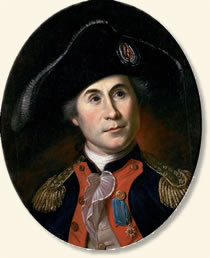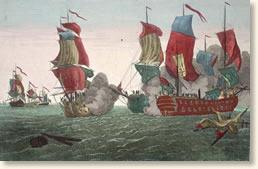Regardless of what orders came across the radio the Lieutenant in charge of that boat was the officer-in-charge at the scene. He had the choice to surrender or escape and die trying if necessary.
Maybe he felt that he should not subject his sailors to a firefight when he got them lost due to his navigational incompetence.
I'd like to think that if that had been me (in charge) I would not have surrendered under any circumstances and that I would bear the brunt of responsibility for the aftermath, including responsibility for the deaths of any of my sailors.
That's what a leader does, IMO.
Surrendering when you have the means to maneuver and fight is unforgivable.
I think we all hope that in the situation we would act as this MAN:
"I Have Not Yet Begun to Fight," 1779
John Paul Jones in Battle
Printer Friendly Version >>>
"I have not yet begun to fight!" This was the immortal retort of Captain John Paul Jones to a request to surrender as he and his crew engaged in a desperate battle with a British frigate off the northern coast of England during the American Revolution.
Born in Scotland in 1747, Jones went to sea at age thirteen and became Captain of his own ship by the time he was twenty-one. By 1775, he had emigrated to America where he volunteered for service in the fledgling American Navy and was given his own command. In 1777 he was dispatched to the European waters with orders to create whatever havoc he could accomplish including attacking British ships and sea ports.
In 1779 Jones took command of the 42-gun Bonhomme Richard a reconstituted merchant ship given as a gift to the Americans by the French. Leading a squadron of five ships, Jones attacked the coast of Ireland and then sailed north around the tip of Scotland to a point off the coast of Northern England where on September 23, 1779 he encountered a large merchant convoy escorted by two British naval vessels. The stage was set for John Paul Jones’s most famous naval battle.
"Has your ship struck? "
An observer aboard Captain John Paul Jones's ship describes his most famous battle:
"On the 23d of September, 1779, being below, I was roused by an unusual noise upon deck. This induced me to go upon deck, when I found the men were swaying up the royal yards, preparatory to making sail for a large fleet under our lee. I asked the coasting pilot what fleet it was. He answered:
'The Baltic fleet, under convoy of the
Serapis of forty-four guns, and the
Countess of
Scarborough of twenty guns.'
A general chase then commenced of
the Bonhomme Richard, the
Venseance, the
Pallas, and the
Alliance [American ships in Jones's squadron].
At this time our fleet headed to the northward, with a light breeze, Flamborough Head being about two leagues distant. At 7 P.M. it was evident the Baltic fleet perceived we were in chase, from the signal of the
Serapis to the merchantmen to stand in shore. At the same time, the
Serapisand
Countess if Scarborough tacked ship, and stood off shore, with the intention of drawing off our attention from the convoy. When these ships had separated from the convoy about two miles, they again tacked and stood in shore after the merchantmen. At about eight, being within hail, the
Serapis demanded:
"What ship is that?"
He was answered: "I can't hear what you say." Immediately after the
Serapis hailed again:
At this moment I received orders from Commodore Jones to commmence the action with a broadside, which indeed appeared to be simultaneous on board both ships. Our position being to windward of the Serapis, we passed ahead of her, and the
Serapis coming up on our larboard quarter, the action commenced abreast of each other. The
Serapis soon passed ahead of the
Bonhomme Richard, and when he thought he had gained a distance sufficient to go down athwart the fore foot to rake us, found he had not enough distance . . . and the
Bonhomme Richard, having headway, ran her bows into the stern of the
Serapis. We had remained in this situation but a few minutes when we were again hailed by the
Serapis:
"Has your ship struck?"
To which Captain Jones answered: "I have not yet begun to fight."
As we were unable to bring a single gun to bear upon the Serapis, our topsails were backed, while those of the
Serapis being filled, the ships separated. The Serapis bore short round upon her heel, and her jib boom ran into the mizen rigging of the
Bonhomme Richard. In this situation the ships were made fast together with a hawser, the bowsprit of the
Serapis to the mizenmast of the
Bonhomme Richard, and the action recommenced from the starboard sides of the two ships .... A novelty in naval combats was now presented to many witnesses, but to few admirers. . . .
From the commencement to the termination of the action, there was not a man on board the
Bonhomme Richard ignorant of the superiority of the
Serapis, both in weight of metal, and in the qualities of the crews. The crew of that ship was picked seamen, and the ship itself had been only a few months off the stocks; whereas the crew of the
Bonhomme Richard consisted of part American, English, and French, and a part of Maltese, Portuguese, and Malays, these latter contributing, by their want of naval skill and knowledge of the English language, to depress rather than elevate the first hope of success in a combat under such circumstances.
Neither the consideration of the relative force of the ships, the fact of the blowing up of the gundeck above them by the bursting of two of the eighteen pounders, nor the alarm that the ship was sinking, could depress the ardor or change the determination of the brave Captain Jones, his officers and men. Neither the repeated broadsides of the Alliance, given with a view of sinking or disabling the
Bonhomme Richard, the frequent necessity of suspending the combat to extinguish the flames, which several times were within a few inches of the magazine, nor the liberation by the master-at-arms of nearly five hundred prisoners, could change or weaken the purpose of the American commander. At the moment of the liberation of the prisoners, one of them, a commander of a twenty-gun ship taken a few days before, passed through the ports on board the
Serapis, and informed Captain Pearson that if he would hold out only a little while longer, the ship alongside would either strike or sink, and that all the prisoners had been released to save their lives. The combat was accordingly continued with renewed ardor by the
Serapis.
The fire from the tops of the
Bonhomme Richard was conducted with so much skill and effect as to destroy ultimately every man who appeared upon the quarter-deck of the
Serapis, and induced her commander to order the survivors to go below. Nor even under shelter of the decks were they more secure. The powder-monkeys of the
Serapis, finding no officer to receive the eighteen-pound cartridges brought from the magazines, threw them on the main deck, and went for more. These cartridges being scattered along the deck, and numbers of them broken, it so happened that some of the hand grenades thrown from the main-yard of the
Bonhomme Richard, which was directly over the main hatch of the
Serapis, fell upon this powder, and produced a most awful explosion. The effect was tremendous. More than twenty of the enemy were blown to pieces, and many stood with only the collars of their shirts upon their bodies. In less than an hour afterward the flag of England, which had been nailed to the mast of the
Serapis, was struck by Captain Pearson's own hands, as none of his people would venture aloft on this duty; and this, too, when more than 1,500 persons were witnessing the conflict, and the humiliating termination of it, from Scarborough and Flamborough Head."






